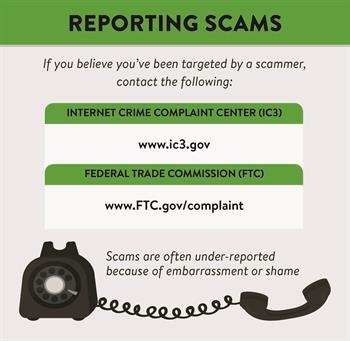It's a Money Thing®
How to Spot Scams
If you use a cellphone or have an email account, you’ve almost certainly been exposed to an attempt at mass marketing fraud. Common examples include being interrupted by an annoying robocall just as you start eating lunch, or waking up to a suspicious message in your email inbox that somehow slipped through the spam filter. Sometimes, the attempted fraud is kind of funny—the wording is so strange or the premise is so ridiculous (“An exiled prince needs my help transferring a million dollars? Really?”) that we’re left wondering how anyone could possibly fall for such an obvious money grab.
Unfortunately, mass marketing scams persist because they work—at least enough to justify the attempts made. In a 2015 Data Breach Investigation report conducted by Verizon, it was found that it takes an average of 82 seconds from the time a phishing campaign is launched for the first victim to fall for the trap.
How is it that scammers are able to trick the average person into making costly and humiliating mistakes? How is it that even the smartest people can fall for the simplest scams?
Fear, urgency or threatening behavior can trigger a reaction in your brain that sidesteps the usual neural pathways and compels you to act before any rational thought can kick in—and this is what many scams are designed to get you to do.
So how can you protect yourself from these situations? Your first step is being aware of what scams are out there.


Familiarizing yourself with common scams can help you spot them before they turn into costly mistakes.
- Unexpected Money: A "wealthy person" asks for help with the transfer of a large sum of money, while the target is required to pay fees, write a check, or provide account access in order to complete the transfer of funds and never receives the money.
- Buyer-Seller Fraud: The target comes across a tempting online listed for a premium item at an extremely low price. Scammers collect the payment but never deliver the product. Multiple accounts and fake reviews are used to disguise their deception.
- Identity Theft: The target is asked to log into their account or confirm their password via phone or email. Scammers may also pose as friends or family and ask a series of leading questions to get personal information. The scammer then uses these personal details to open accounts or sell it on the dark web.
Avoid falling prey to scammers by using the following tips:
- Buy some time: In an emergency, it's natural to act before you have time to think. It's no coincidence that many scams are designed to encourage an immediate reaction, before you have a change to spot any red flags. All yourself to take a minute to assess a situation, even if it seems urgent.
- Use the address bar: Get in the habit of visiting websites directly instead of following links contained in emails. It takes only a few extra seconds and helps you be more mindful about your online activity.
- Cross-reference: It's perfectly reasonable to verify the identity of the person or business you're in contact with. Use a means outside of the original communication, like doing a separate web search or returning a call through a publicly listed number.
If you believe that you've been targeted by a scammer, contact the authorities to report the incident. Scams are often times under-reported.

Whether it’s online, over the phone, or in person, scammers are always coming up with new ways of influencing their targets to act in ways they might not otherwise. By staying calm in high-stress situations and by giving ourselves a little extra time to think, we’re better able to spot recurring scammers’ favorite tactics and to save ourselves from making costly mistakes.
